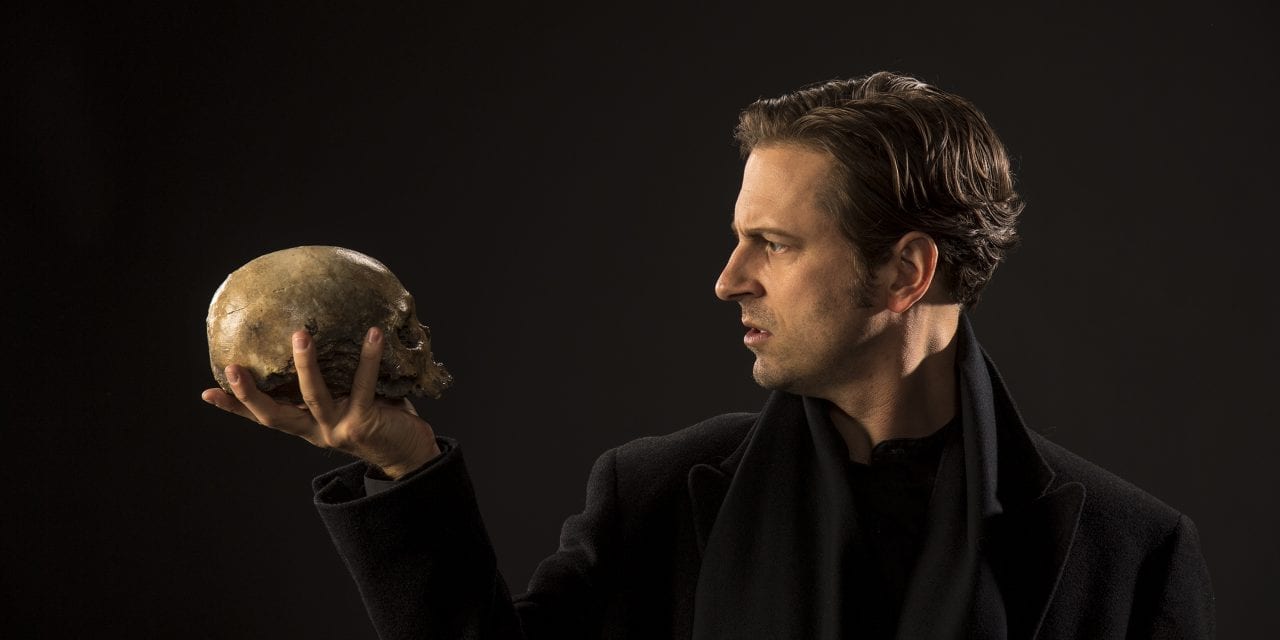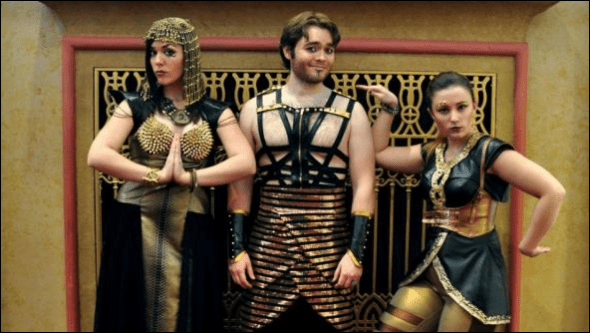CEDAR CITY — “Sweets to the sweet,” states Queen Gertrude at Ophelia’s funeral. This mournful farewell captures my regret as I left the Utah Shakespeare Festival‘s production of Hamlet. It is a production that is easy to grow fond of, because its greatest flaw is that it had to end.

Show closes October 12, 2019.
Director Brian Vaughn makes Hamlet relevant by showcasing the personal tragedy of the story over the politics of the play. For Vaughn, Hamlet is about the breakdown of a family through betrayal and vengeance. Consequentially, this production is remarkably intimate (even in the 765-seat theater). The breakdown of family is especially apparent in a surprise addition to the staging that shows that everyone connected with Hamlet has a hand in bringing misery to the castle.
Vaughn is an actor’s director, and it shows in a character piece like Hamlet. Vaughn helps his performers build real characters who have real relationships with one another. It is so easy to recognize the camaraderie between Hamlet and Horatio (played by Jeremy Thompson), or the sibling partnership and fondness between Ophelia (played by Emma Geer) and Laertes (played by Christopher Peltier). These interactions are so grounded in reality that the tragedy of their destruction feels utterly devastating as the events of the play unfold.

Christopher Peltier (left) as Laertes and Emma Geer as Ophelia in the Utah Shakespeare Festival’s 2019 production of Hamlet. (Photo by Karl Hugh. Copyright Utah Shakespeare Festival 2019.)
My only reservation about Vaughn’s direction is the woman in the nightgown who is on stage in Polonius’s quarters during Act II. Her presence is distracting and does nothing to enhance the scene. But it is a short scene, and the minor disturbance is easily forgiven.
Quinn Mattfeld seems to be congenitally incapable of giving a bad performance. For Hamlet, Mattfeld committed the daring choice of making Hamlet fully sane. As a result, Hamlet is fully accountable for the deaths he causes. A less talented actor would struggle to make this work, because some scenes (such as when Hamlet spurns Ophelia) would make the character appear unnecessarily cruel. Mattfeld gets away with this decision, though, by making Hamlet impish and taunting, such as when he withholds information about the location of Polonius’s body, or the “Words, words, words” scene. The glint in Mattfeld’s eye and lighthearted nature of the character soften the harshness of Hamlet’s actions and make him an endearing protagonist.

Quinn Mattfeld (left) as Hamlet and Jacqueline Antaramian as Gertrude in the Utah Shakespeare Festival’s 2019 production of Hamlet. (Photo by Karl Hugh. Copyright Utah Shakespeare Festival 2019.)
A lighthearted Hamlet may strike some readers as a surprise, but the script is infused with humor. Shakespeare had to keep the groundlings happy, and a snappy joke at regular intervals was an effective way to do that. Mattfeld worked with Vaughn to create a Hamlet that uses humor to release the play’s tension periodically and to provide a soothing contrast to an otherwise foreboding mood. Real people use humor to cope with difficult situations, and the jokes in the play bring out the humanity in the characters.
Another standout is Armin Shimerman as Polonius. The affection that Polonius shows toward Ophelia and Laertes strengthens the familial theme of the production. Polonius’s cantankerous demeanor when giving advice to Laertes has a loving undertone. This Polonius, though, is more than a family man: he is a wily politician who is willing to adapt to the circumstances he sees in order to keep his job. This wily politician is most apparent in Act III when Polonius agrees with Hamlet’s capricious and fluctuating opinions about the shape of a cloud. The way Shimerman has Polonius resign himself to the pointless discussion shows that Polonius sees such pointless activities as the price he pays for power and security.

Armin Shimerman (left) as Polonius and Christopher Peltier as Laertes in the Utah Shakespeare Festival’s 2019 production of Hamlet. (Photo by Karl Hugh. Copyright Utah Shakespeare Festival 2019.)
At first, Jacqueline Antaramian‘s Gertrude has a stoic deportment that makes her seem like a typical Shakespearean queen. However, Gertrude’s mask of resignation drops as the play progresses, until she, too, is sometimes consumed by the stresses placed on the family. Gertrude’s fear when she sees her son murder Polonius shows that she knows that no one is safe, including herself. I also adore the tenderness in her description for Ophelia’s death, a moment twinged with irony, thanks to Vaughn’s clever staging.
The rest of the cast is as capable as these leads, but it would be tedious to list all the ways that each person delighted me. Andrew May is a Claudius with a temper that increased the danger Hamlet faced, especially when the two came to blows after the intermission. Geer is a tragically broken Ophelia, whose distress at Hamlet’s rejection is touching. Geer is heart-wrenching in Ophelia’s last scene, because her insanity originates in a place of deep pain for the character. The various messengers and court attendants in the cast are also effective in establishing the self-contained world of the play.
Vaughn set this production of Hamlet in the years before World War I, a precarious time for European monarchies. The opulent set (designed by Jason Lajka) reflects the kingdom’s past glories, and the men’s grey military uniforms (designed by Bill Black) serve as a reminder of the drab, tumultuous world outside of the Elsinore bubble. This mix is a perfect metaphor of the political problems facing the royal family because of their traditional outlook that is incapable of handling the unexpected events encountered. I am also intrigued by the small snow drifts that accumulate on the stage, which provides little flashes of white on an otherwise dark stage. The snow motif is also used in a gorgeous moment when Hamlet is so distressed after meeting the ghost that he breaks down into a crying mess with the snow gently falling around him.

Andrew May (left) as Claudius, Quinn Mattfeld as Hamlet, and Jeremy Thompson as Horatio in the Utah Shakespeare Festival’s 2019 production of Hamlet. (Photo by Karl Hugh. Copyright Utah Shakespeare Festival 2019.)
However, the technical element that does the most to establish the mood of Hamlet is Joe Payne‘s sound design. The cacophonous overlap of bells and music that open the show and the distortion of the ambient sounds in early scenes foreshadow the dark events of the play. Most terrifying, though, is the echoing voice of the ghost (played by John G. Preston), which is so powerful that Hamlet feels compelled to do the ghost’s bidding. The thunderous commands resonate through the theater and convey the authority of both a father and the grave.
Hamlet has had staying power for over 400 years, and in the Utah Shakespeare Festival’s production, it is easy to see why. Vaughn and his cast, with engineering-level precision, have crafted a tragedy that is endlessly rewarding to watch. The remorse that comes with the play’s ending is a small price to pay for the three hours spent admiring the work of some of the most gifted artists and designers available.





